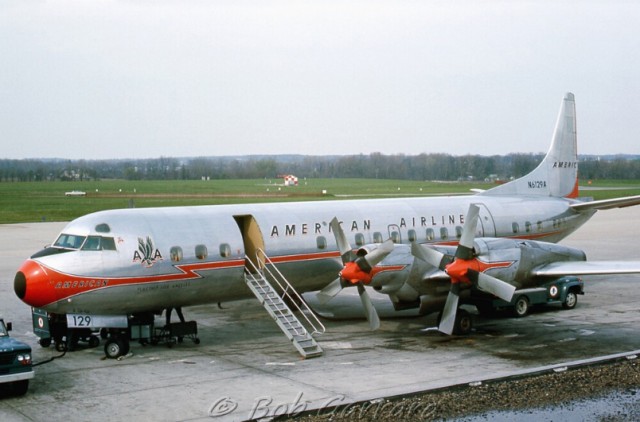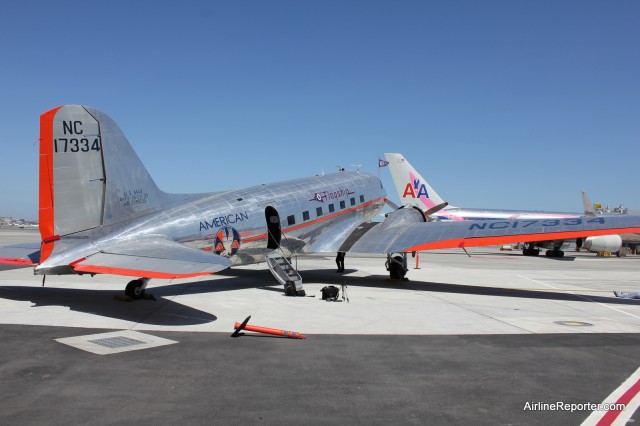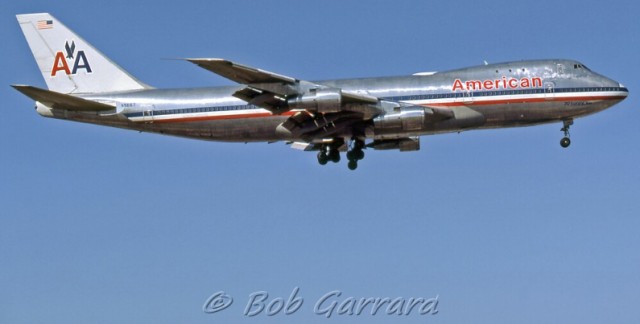
American’s First Boeing 777-300ER, N718AN, seen at DFW Gate D-23, the day of departure flew the inaugural flight. Much more than just a new aircraft joining the fleet, It signifies the re-birth of an iconic airline. Image from Chris Sloan / Airchive.com.
This is a multi-part story written by Chris Sloan (@Airchive) on the changes at American Airlines and the inaugural Boeing 777-300 flight to Sao Paulo.
On January 31, 2013 American Airlines launched their first Boeing 777-300 ER into service with attention that rivaled any airline’s launch of a new type in recent memory. On the face of it, even though American became the first operator of the 777-300 in the United States, this event would almost seem overkill if for that reason alone. After all, American began 777-200 flights back in 1999 and the first 777-300 was first delivered to an airline, Cathay Pacific back in May, 1998. The first 777-300ER entered service nearly 10 years ago with Air France. Boeing’s two stretch variants of their venerable cash cow, the 777, easily have become the type’s most popular versions with over 680 orders and deliveries between them out of the entire 777 program’s 1,380 orders and deliveries. (as of December, 2012). In an era of smaller airliners, American inaugurated the 777-300, the largest new airliner by a U.S. carrier since the last Boeing 747-400s entered service with U.S. airliners in the late 1990s.
This inaugural, flight 963, from Dallas/Ft. Worth to São Paulo, Brazil in the author’s view is one of the most significant in the airline industry in years because it is about something much bigger than just the launch of a new airliner, it’s about the re-birth of a proud American institution that happens to bear the name of our country ’“ American Airlines.

American Airlines Electra at Port Columbus International Airport (CMH) in 1967. Image by Bob Garrard.
American Airlines problems are well known. After becoming the world’s largest airline with its 2000 acquisition of TWA, the 2000s were not kind at all to the Silver Bird. TWA and American merged during an economic downturn and by most accounts, the merger was anything but an unqualified success.
American shed most of TWA’s assets, routes, staff, and many of its aircraft. On September 11th, 2 of American’s airliners, their crew, and passengers were forever lost in the atrocities of this horrible day. As if things couldn’t get any worse, the world’s airline industry hemorrhaged with the U.S. legacy carriers losing more money during this time then they had profited in their entire history. All of them declared Chapter 11, with the exception of American. Under the category of ’œno good deed goes unpunished’, this decision would come back to haunt American for years.

American Airlines pioneered nonstop Transcontinental flights in 1953 with its Mercury Douglas DC-7 service. Click for larger. Image from Chris Sloan / Airchive.com.
The competitors were able to re-organize, upgrade service, rebrand their images, get their costs under control, renew their fleets, expand their route structure, and finally in the case of Continental/United and Delta/Northwest consolidate into mega-carriers that dwarfed American. American was left with a barrage of serious problems: a revolving door in the executive ranks, fractious management and labor relations, dwindling market share, increasingly massive financial losses as their competitors recorded profits, devastating operational problems of which many were self-inflicted, an aging fleet, outdated and stripped down in-flight passenger service, soaring operating expenses, declining bookings, and a very unsympathetic press that at times almost seemed on a witch hunt.
Like Pan Am and other failed airlines there were a few bright spots: the extremely profitable Latin American hub, the North Atlantic / London Heathrow joint-venture with British Airways, the strong and dominant hubs particularly at DFW and Miami, strength on the highly profitable trans-continental services particular JFK-LAX, and many proud employees across all positions who still believed their company could once again live up to American’s 1980s advertising claim that they were ’œSomething Special in the Air’.
But the headwinds seemed to far outweigh the tailwinds and finally on November 29, 2011 American filed for Chapter 11 bankruptcy becoming the last U.S. legacy carrier to do so. On top of that, US Airways began aggressively pursuing a merger, securing an agreement with the pilots unions. Then came the 2012 ’œSummer of Discontent’ with flight cancellations and operations disruptions that sent customers into the arms of their competitors and who can forget the seats onboard a few 757s becoming unbolted during flights. It would have been understandable for the once proud Eagle to fold its wings. If the one unthinkable collapses of majors like Pan Am and Eastern occurred, could American meet the same fate?
It may be hard to remember, but since the beginning of commercial aviation: American was an innovating pace setter in the industry, and generally a profitable one at that. In many ways, American virtually wrote the history of the airline industry: American introduced the airliner that changed aviation, the Douglas DC-3. The first non-stop transcontinental services were flown by American in 1953 and then they pioneered the first regularly scheduled domestic jet services in 1959. Their legendary CEO C.R. Smith, along with an American 707 Astroliner, appeared on the cover of Time Magazine for this honor. American was the launch customer for other airline types such as the Douglas DC-10 (which was based on their specifications) and the blazingly fast Convair 990.

A restored American Airlines DC-3 at SFO in 2011. Image via AirlineReporter.com.
American even leased to NASA and maintain the 747s used to ferry the Space Shuttle. Of even greater significance, American introduced the first airline computer reservation system, Sabre, back in 1961. In 1981, they created the world’s first frequent flyer program, still known as AAdvantage. Under their controversial but genius CEO Robert Crandall, American became the leader in dynamic pricing and computerized yield management as well as cost control, which made the airline very profitable. They were even the first airline to introduce a wireless app back in 1999 on the Palm Pilot, long before they were in vogue.

Beginning in 1961, American was the first airline to equip their Boeing 707 jets with FanJet technology which improved range, fuel economy, speed, and were less polluting then the original “water wagon” turbo-jet Pratt and Whitney engines. Click for larger. Image from Chris Sloan / Airchive.com.
Along the way, they acquired numerous airlines such as Trans Caribbean, AirCal, RenoAir, and finally TWA.
With that spirit of innovation and comeback even in the face of severe turbulence, American chose to move forward even before the Chapter 11 filing. On January 19, 2011 American became the first U.S. airline to order the Boeing 777-300 ER, the world’s most successful twin-engine airliner. Initially ordering 2 and then upping the order to 10 with options to covert other Dash 200s, AA would initially use the 777-300 ER on super high density premium routes to South America and London from their major hubs at DFW, MIA, LAX, ORD, and JFK. London Heathrow was announced as the initial destinations, but perhaps in a nod to the importance of Latin America and particularly economically booming Brazil, São Paolo became the inaugural destination. The first 2 777-300ERs delivered are scheduled to only be deployed on this route through March until London Heathrow is added.
On July 20, 2011 American ordered $13 billion worth of 460 narrow-body Boeing and Airbus aircraft, the largest commercial aircraft order in history. This fleet renewal, designed to replace the aging MD-80s, 757s, and 767-200s, consists of 200 aircraft from the Boeing 737 family: The 737-700, 800, 900ER, and the new ultra fuel-efficient 737 Max (which it launched). From Airbus, a company previous management had vowed never to do business with again, American ordered 260 aircraft from the Airbus A320 family including the 320, 320 Neo, and new 321 which would become the new Transcontinental Flagship with a game changing cabin experience beginning in November, 2013.
Reportedly, the airline gained even better terms in negotiations during bankruptcy. Even after the bankruptcy filing AA continued other upgrades such as Wi-Fi across the domestic fleet and international satellite Wi-Fi for international flights, new Boeing Sky Cabin equipped 737s at the rate of approximately 3 per month, Samsung Galaxy tablets for use by premium passengers for in-flight entertainment and by flight crew for a myriad of flight information, in-fight streaming of movies and video content, and innovative new pricing options called ’œChoice’.

American’s first 777-300ER (N717AN) rolled out from Boeing’s Everett Plant in late October, 2012 painted in a dull-gray fuselage instead of AA’s traditional polished aluminum look further fanning the flames that a new look was in the works.
Image Courtesy: Russell Hill
The long in the tooth vintage 1980s and 90s era cabins received much attention as well new extended legroom Main Cabin Extra, a new transcontinental Flagship Business and First Class product with lie-flat seats, a new long-haul Business and First Class product debuting on today’s 777-300 flight, and new leather seats in economy. Power on demand throughout all new aircraft and cabins would become the exception rather than the rule. American also confirmed its order for the arrival of 787-8 and 787-9 Dreamliners commencing in 2014-15. Unlike many airlines that wait for exiting from bankruptcy before announcing upgrades, American announced many of these changes from the outset of its reorganization and continued throughout the proceedings even during the US Airways merger discussions.
Almost 2 years after placing the order, on December 11, 2012 Boeing delivered the first 777-323ER to American. The plane, sans fanfare was ferried in its still anonymous scheme from Everett’s Paine Field to the DFW base and quickly placed in a hanger. A second 777-300ER (N718AN) was delivered quietly on December 19th with the next 8 following in 2014. These planes were delivered a bit late, reportedly due to the new Zodiac UK First Class seats not being ready in time postponing the inaugural from early January 2013 to January 31. A 3rd 777-300ER was delivered in early January while its stable mates made a few proving trips, including the MIA hub to test the IFE and Satellite Wi-Fi.

This proposed new American livery, designed by Anthony Harding, gained a lot of traction in the Blogosphere.
After a tough fall, American began to gather momentum in its operational and financial results. It reported revenue of $24.9 billion in 2012, the highest in company history and a full-year operating profit of $494 million, excluding special items, a $749 million improvement over 2011. These were impressive, especially given the operational issues of the Summer and Fall and losses cased by Hurricane Sandy.
Perhaps the most excitement surrounded the mystery of the new brand. There have been rumors for years that the airline’s 1968 era and virtually unchanged since then, signature polished aluminum look and Massimo Vignelli’s stylized Eagle would be replaced. Since Eastern’s demise, American is the only major U.S. airline that leaves the majority of its aircraft surfaces unpainted. This was because C. R. Smith hated painted aircraft, and refused to use any liveries that involved painting the entire plane. Robert “Bob” Crandall later justified the distinctive natural aluminum finish by noting that less paint reduced the aircraft’s weight, thus saving on fuel costs. With new aircraft like the 787 Dreamliner and Boeing 737 Max coming online having more composite surfaces, the unpainted look technically would no longer be possible.

American Airlines Boeing 747 taken in 1977 by Bob Garrard.
This rebrand was more than a rumor, one that CEO Tom Horton did little to discourage. When the first 777-300 ER (N717AN) rolled out in late October, 2012, with a gray fuselage and white tail, it virtually confirmed a new livery was in the works. The blogosphere went abuzz with speculations and designs of what that might look like, but American kept this as tight as a state secret. Suddenly in the early morning hours of January 17, 2013, American Airlines sent out a press advisory that the new look and livery would be introduced to the world at 9:00AM CST that same day with a live webcast. Immediately, a 2 hour countdown began on the airline’s website, AA.com.
At the appointed hour, a stream of a pre-produced video began featuring CEO Tom Horton recounting the history of American and its progress in reinventing itself and then with the CEO’s words, ’œSince placing our landmark aircraft order in July of 2011, we’ve been building anticipation toward a moment in time when the outside of our aircraft reflects the progress we’ve made to modernize our airline on the inside’, a computer graphic montage of the Boeing 777-300ER with the new look appeared on-screen. But where was the real thing? In true cloak and dagger form, while everyone was expecting one of the 777-300ERs to be the first painted in the scheme, a Boeing 737-800 arrived stealthily that morning from Victorville, CA emblazoned with the new look.

American Airline’s previous livery on different aircraft types. Image from Chris Sloan / Airchive.com.
The 777-300ERs were spirited out the night before the reveal for their visit to the paint shot with the first returning painted the Sunday before the inaugural. As an aside, Virasb Vahidi, American’s Chief Commercial Office revealed to Dallas TV station WFAA that the new look and logo had been finalized a year ago. He was amazed that that ’œthe new look didn’t leak.”
American’s CEO Horton only tipped US Airways CEO Doug Parker the night before that the reveal would be the next morning, but was quoted as saying the US Airways team did not see it before nor have any input. American said that by the end of 2013, they expected a third of the fleet to features the look with all planes completed within 5 years. The website and Twitter feed immediately changed to the clean, new look.

The World’s first look at American’s new branding was on this computer generated of the new Boeing 777-300ER as they had not been painted in the new livery at the time of the debut.
The new Futurebrand designed livery features a silver mica paint that was chosen as a way to maintain the heritage of the unpainted aluminum look. Just beyond the flight deck, the updated Eagle insignia features the beak pointing right with a blue and red geometric shape flanking it on top and bottom. Aft of the logo, The word ’œAmerican’ dominates the forward fuselage top to bottom. It is evocative of the Pan Am ’œBillboard’ look of the 1980s and was one of the rumors that turned out to be correct. These elements were generally well received as ’œelegant’, ’œclean’, and ’œa needed update’, though some did compare the new logo to that of Greyhound Bus. Personally, I found the fuselage an elegant and sophisticated change. The tail itself, with its 11 red and white stripes and 7 blue bars echoing an American flag met with decidedly mixed reaction.
Some called it ’œgaudy’, ’œfugly’, though most agreed it was ’œpatriotic’. Others went so far as to compare it to Aeroflot (due to the abstract flag design concept on the tail and silver fuselage paint) with many questioning why some iteration of the classic and beloved Eagle icon wasn’t used on the tail. Many pundits openly hoped that if there is indeed a merger with USAirways that the airline would change course. Unsurprisingly, the classic 1968 logo’s designer Massimo Vignelli was the harshest pundit saying in ’œBusiness Week’ that ’œthe new logo has no sense of a permanence. There was no need to change. I bet this logo won’t last 25 years’.

A Boeing 737-800 surprisingly, instead of the new 777-300ER Flagship was the first airliner painted in the new livery. It was flown in stealthily the morning of the announcement and put on display for employees and press in a hanger in front of an unpainted 777-300ER. The 777-300ER flew out later that day for painting in Victorville while the 737-800 went on a tour of American’s hubs. Image courtesy: American Airlines
Initial reactions to changing icons like American’s iconic Eagle or United’s Sal Bass designed Tulip are often very critical, so this was to be expected. In my opinion, the new ’œSoaring Spirit’ look is necessary upgrade given the need of American to re-position itself in the minds of the flying public. Upon seeing it in person I found it quite striking and believe it will grown on people, though certainly not everyone agrees. Virtually everyone agrees, however, that a new livery is just paint and ’œwindow dressing’ so the real test would be the airline’s new product on the ground and in the air. Fans of the current livery will be pleased to know that American will be retaining 1 of their aircraft in the current livery as a “new” Retrojet (possibly the Susan B Komen 777), as well as the current “AstroJet” 737.
READ PART TWO OF AMERICAN AIRLINE’S INAUGURAL BOEING 777-300ER FLIGHT
CHECK OUT TONS OF PHOTOS FROM THE 777-300 INAUGURAL FLIGHT which are on his site Airchive.com (you will probably also enjoy all the other great airline memorability, photos and stories on there too).
 |
This story written by…Chris Sloan, Correspondent.Chris has been an airline enthusiast, or #AvGeek, since he was 5 years old. Over the years, he has amassed an extensive collection of aviation memorabilia and photos that he shares on his site, Airchive.com. He is the President and Founder of the TV production and promotion company, 2CMedia.com and Executive Producer and Creator of ’œAirport 24/7’ Travel Channel series. |
I keep reading that American is the first operator of the B777-300ER in North America. Air Canada has been operating the B777-300ER for many years now. Its website shows B777-300(77W) in its fleet profile.
I flew on one to SYD and back in 2008. Am I missing something?
You are correct — sorry has been corrected to show in the US.
David